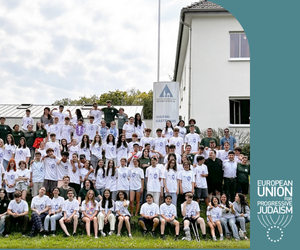Saving Jewish Languages: Yiddish, Ladino, and Others
By Bill Echikson, EUPJ Brussels Director
Wherever Jews have settled, they have adopted local languages and added a Jewish twist – from Yiddish and Ladino to the lesser-known varieties such as Judeo-Tat (Azerbaijan and Dagestan) and Judeo-Malayalam (Southern India). Over the past two centuries, migration and other turbulent historical events have transformed – and threatened – these traditional languages.
The European Union for Progressive Judaism (EUPJ) organised a webinar recently to investigate.
Our findings were surprising. Some supposedly-endangered, historic Jewish languages continue to thrive as spoken languages or objects of affection, while new dynamic ones have emerged, including Jewish English, Jewish Latin American Spanish, and Jewish Russian.
Let’s start with Yiddish. It is flourishing in Hasidic communities around the globe and receives serious attention as an academic subject. “Yiddish is not an endangered language,” said Prof. Sarah Benor from Hebrew Union College-Jewish Institute of Religion (HUC-JIR). Her research shows that modern Hasidic Yiddish is continuing to evolve, developing grammatically and adding vocabulary – signs of vitality.

Top L-R: Prof. Ora Schwarzwald and Bill Echikson
Bottom L-R: Harry Swalef and Prof. Sarah Bunin Benor
Ladino also is surviving. While most of the native speakers are elderly and the language is endangered, preservation and promotion efforts remain strong, according to Prof. Ora Schwarzwald, president of the Israel National Academy of Ladino and professor emerita in the Department of Hebrew and Semitic Languages at Bar-Ilan University. Recent Ladino literature includes a Bulgarian Ladino Haggadah written in Cyrillic letters. “There is a lot of activity: courses in Ladino are taught in Israel, Madrid, and Hamburg,” Schwarzwald said.
To be sure, many Jewish languages are declining and some risk extinction. In the 1950s, Judeo-Arabic speakers left their homelands and immigrated to Israel and elsewhere. While some singers continue to use the language in contemporary songs, such as Israeli Neta Elkayam, the language is “moribund,” fears Prof. Benor.
Similarly, Judeo-Tat, Judeo-Median (a group of non-Persian languages used in Iran), Jewish Neo-Aramaic (used in the Kurdish regions of Iran, Iraq, and Turkey) are vanishing, with most of the speakers living in Israel and the United States and advanced in years. Within two decades, Benor fears that most long-standing Jewish languages will disappear.

Even Yiddish faces significant challenges. The Dutch and German/Western European variant of the language is now extinct, said our third panellist Harry Swalef, a linguist originally from Amsterdam. “The only variety of Yiddish now learnt by younger generations is Litvak, Eastern Yiddish, which has become the standard form of the language,” he said.
Threatened diaspora languages must be rescued because they represent an important part of Jewish history, the speakers agreed. This means studying and documenting them before it is too late. The Israeli government provides significant support. Universities around the globe are mobilising. Prof. Benor has created this Jewish Language Project, which promotes research and education about the languages.
While preservation remains key, hope exists for the creation of “new” Jewish languages. In recent decades, Prof. Benor noted the emergence of Jewish Swedish, Jewish Russian, Jewish Hungarian, Jewish American English, and other combinations of modern languages with elements of Hebrew, Yiddish, and other languages. In addition, all three panellists are heartened by the increasing engagement with Yiddish, Ladino, and Judeo-Arabic.
“Not long ago, these languages were seen as corrupt languages, ‘jargons’,” said Benor. “Today, we see them as a treasure trove.”
This article was first published in The Times of Israel.








